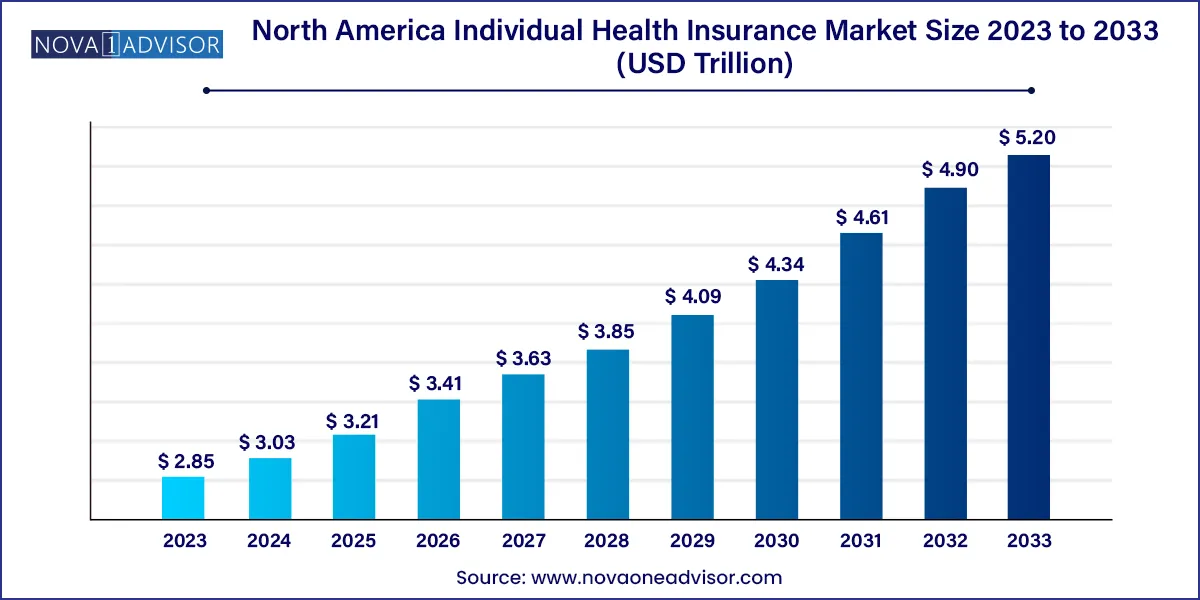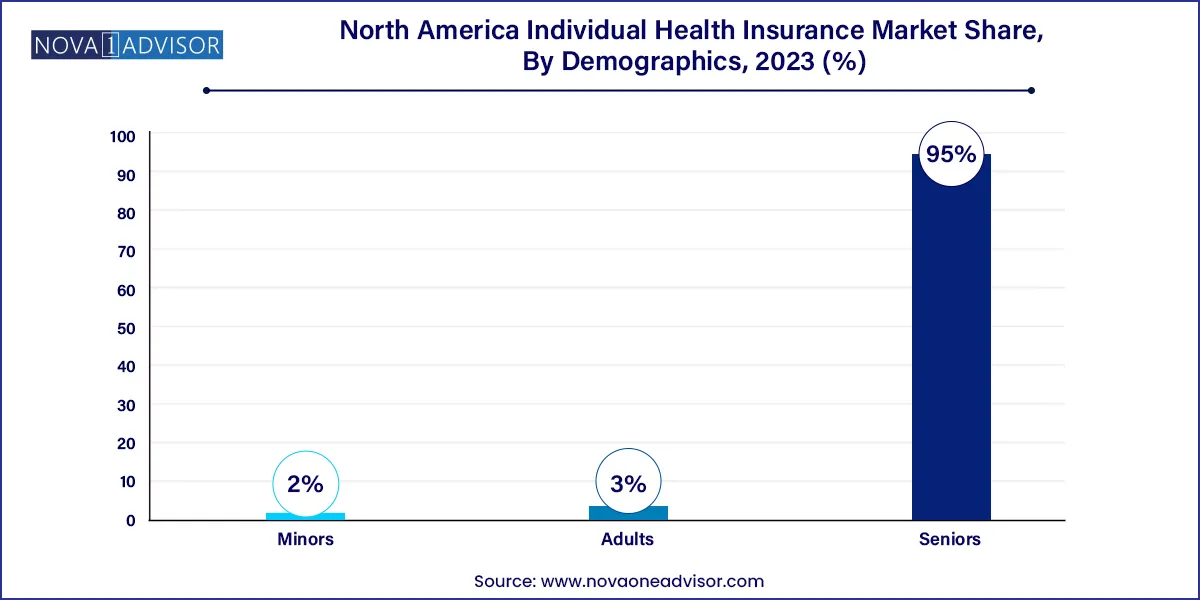North America Individual Health Insurance Market Size and Trends
The North America individual health insurance market size was exhibited at USD 2.85 trillion in 2023 and is projected to hit around USD 5.20 trillion by 2033, growing at a CAGR of 6.2% during the forecast period 2024 to 2033.

Key Takeaways:
- Based on types, the public segment dominated the market in 2023 and accounted for the maximum share of 90.0% of the overall revenue.
- The private segment is anticipated to register the fastest growth rate over the forecast period.
- The seniors segment dominated the industry in 2023 and accounted for the maximum share of over 95.0% of the overall revenue.
- The adult segment is estimated to register the fastest growth rate over the forecast period.
- Canada is expected to register a lucrative growth rate during the forecast period.
Report Scope of The North America Individual Health Insurance Market
The increasing prevalence of chronic disorders is a major factor contributing to the growth of the market. It can be very challenging for people to receive treatment for chronic conditions like cancer and heart disease. Many individuals, thereby, choose health insurance to prevent the sudden weight of having to pay a large sum of money for hospitals and other medical bills. More than half of Canadian adults reported having one or more chronic illnesses in the 2018 Health Care in Canada (HCIC) survey, with the most prevalent diagnoses being Cardiovascular Diseases (CVDs), arthritis, lung disease, and mental health problems, either separately or in combination.
The majority of people in North America rely on government health insurance or employer-sponsored health insurance schemes; however, these schemes only offer limited coverage to individuals. The need for individual health insurance is rising as a result of rising healthcare costs. Also, compared to the family floater or group health insurance, individual health insurance is advantageous as each person has their sum insured, as opposed to other plans where the sum insured is split among all individuals covered in the policy.
According to an article published by BDO USA, during the COVID-19 pandemic, more than 20 million people lost their jobs in April alone as the unemployment rate in the U.S. jumped drastically from 3.5% in January 2020 to 14.7% in April 2020. Since jobs are the primary source of health insurance for Americans, the loss of jobs resulted in millions of workers losing their job-based health insurance coverage. This resulted in a detrimental effect on group health insurance and increased adoption of individual health insurance by people. The market is also anticipated to expand as a result of the increased insurer engagement and new product introductions.
North America Individual Health Insurance Market By Type Insights
Based on types, the public segment dominated the market in 2023 and accounted for the maximum share of 90.0% of the overall revenue. The majority of people in the U.S. and Canada have access to government-sponsored health insurance. The universal health care system in Canada is financed by taxes. Each province and territory have a unique health plan that includes various services. In the U.S., Medicare is a federal government program that provides health insurance for individuals aged 65 years or older. The program also covers people under the age of 65 years, who have certain disorders or disabilities. This scheme covers about 55 million beneficiaries.
The private segment is anticipated to register the fastest growth rate over the forecast period. Although the majority of health care in Canada is covered by the government, private health insurance is a significant supplemental source, especially for prescription medications, dental work, and eye care. Also, many people are making investments to better safeguard themselves from the financial problems brought on by healthcare due to the rising expense of healthcare. Private insurance frequently provides more options as compared to government schemes like Medicare. Furthermore, the advantages of private health insurance include shorter wait times, more specialized care, and state-of-the-art facilities.
North America Individual Health Insurance Market By Demographics Insights
Based on demographics, the industry has been segmented into seniors, adults, and minors. The seniors segment dominated the industry in 2023 and accounted for the maximum share of over 95.0% of the overall revenue. Seniors are more likely to buy individual health insurance to cover the rising costs of medical treatments, as they are at a higher chance of contracting several chronic conditions. In addition, all individuals aged 65 years and older are covered by the government-sponsored Medicare health insurance program in the U.S. A small percentage of this population also has access to additional private health insurance plans.

The adult segment is estimated to register the fastest growth rate over the forecast period. This is due to the fact that lifestyle disorders in adults are becoming more prevalent. According to the International Diabetes Federation, in 2021, there were about 32.2 million diabetes cases in the U.S. and this number is projected to reach 36.2 million by 2045. Moreover, the majority of working people are covered by employer-sponsored health insurance plans. However, the level of protection provided by these plans may sometimes be insufficient, which reduces the value of the protection, thus boosting the adoption of individual health insurance plans.
North America Individual Health Insurance Market By Regional Insights
Based on geographies, the industry has been bifurcated into the U.S. and Canada. The U.S. dominated the total market in 2023. The South region in the U.S. dominated the U.S. market in 2023 and accounted for the largest share of 37.5% of the overall U.S. market revenue, as a substantial population is covered by individual health insurance in the region. Furthermore, the market is expected to expand on account of the increased adoption of individual health insurance in the U.S.
Canada is expected to register a lucrative growth rate during the forecast period. Increased revenue-sharing contributions from the governments of Ontario (ON) and Québec (QC) are contributing to the market growth in the country. For instance, according to the 2023 edition of Canadian Life & Health Insurance Data, Ontario contributed C$ 1615 million in individual health premium revenue in 2021, demonstrating a significant revenue contribution compared to other provinces and territories.
Some of the prominent players in the North America individual health insurance market include:
- Cigna
- United Health Group Inc.
- Elevance Health (formerly Anthem, Inc.)
- Health Care Service Corp.
- Kaiser Foundation Health Plan, Inc
- Independence Holding Company (IHC Group)
- Manulife Financial Corp.
- Sun Life Financial Inc.
- The Canada Life Assurance Company
- Scotia Insurance
- Green Shield Canada
Segments Covered in the Report
This report forecasts revenue growth at country levels and provides an analysis of the latest industry trends in each of the sub-segments from 2021 to 2033. For this study, Nova one advisor, Inc. has segmented the North America individual health insurance market
Type
Demographics
Country


